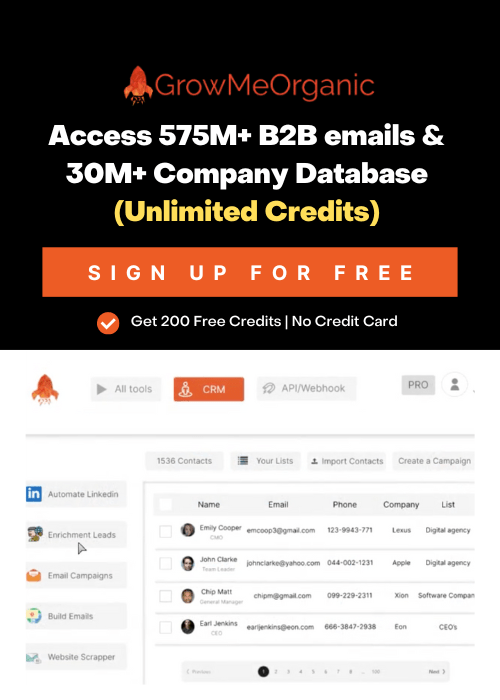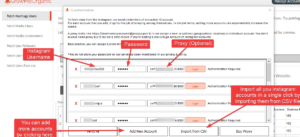What percentage of people open emails that you send? When you maintain a mailing list for a business, brand, organization, or person, you can make your messages more inviting to open. This also applies to those who contact people cold for sales, PR, or any other reason.
When you run an email list, you’ll need an email marketing tool such as GrowMeOrganic. This tool lets you send out messages to large numbers of people, and you can collect statistics about how many people open emails, and messages and click on links.
You can run A/B tests with GrowMeOrganic to test whether changing something about your message, such as the day of the week you send it, impacts its open rate.
Take a look at these tips to boost your open email rate.
Examine the Rules
You must comply with all applicable laws before you do anything with an email list. The law outlines which rules apply to commercial, relationship, and transactional email in each nation. In the US, for example, the CAN-SPAM act outlines the rules.
There is a rule that you cannot use false or misleading headers and subject lines, and if an email is an advertisement, it must be identified as an advertisement. Also, let prompt out if they want. There is more. Read the article.
EU residents must comply with GDPR when it comes to email, even if the sender is based outside the EU.
You should be aware of the rules to avoid violating them when you’re trying to improve your email open rate.
Keep your subscriber list up-to-date
The open rate of your email list lowers if it has a lot of unresponsive subscriber names. Delete dead addresses (those that bounce back) and any subscribers who haven’t opened your emails for a long period (such as those who haven’t opened an email for six months or more).
Offer more ways for People to Sign up
Your emails will be opened more often by users who actively signed up to receive them than by people who were added without their knowledge. Even though some organizations may purchase lists of email addresses, the best subscribers are those who want to receive your messages. Provide multiple ways to sign up for your mailing list.
Your organization’s website, social media accounts, and other places where you can attract new subscribers can help you grow your email list.
There are many free or premium form builders available, such as Google Forms when available, or you can find one that is tailored to your platform. WordPress plug-in form builders, such as those designed for beginners, include drag-and-drop options for GDPR compliance issues.
Keep Your Promises and Be Consistent
Whether they are looking for news summaries, exclusive deals, coupon codes, or insider information, people subscribe to email for a reason. Whenever you send an email, remember to deliver exactly what you promised.
Consistency can be applied to other areas as well. Be consistent. Send an email that matches the style and tone of the brand, product, or organization. Whenever you send an informational message, make sure that the time and date are consistent, such as once per week at the same time and date.
When it comes to sending messages, there is no “right” time or day. Several factors determine whether an email is successful or not, including your audience and the type of message you send. Try different times and days to see if you get better results with that A/B testing.
Pay Attention to Your Subject Line
You cannot control how someone will open your email, but you can influence the subject line. Experiment with various variations so you can find what works best.
Ensure the subject line accurately describes the subject. Never include a question in the subject line. Ensure the subject line is short and catchy. How many words should you include or how many characters? On mobile devices, most experts recommend keeping the subject line between 45 and 100 characters. A good subject line should consist of between six and 10 words.
For every email you send, you should brainstorm five possible subject lines. Get your colleagues to recommend the best subject line. You should also consider what makes you click on the email.
Design the body’s first line carefully
Your subject line will be visible to everyone who receives your email. Several recipients will also see the first few lines of your body in the preview. To reel them in from the subject line, the first line must hook them.
Invest some time in crafting it. Rather than repeating the subject line, write the first line of the body to add to it. Stay on point and avoid clickbait. Be sure to follow through!
Create a custom ‘From’ name
Emails are sent by whom? Consider putting Jackie or Paul’s names in the ‘from’ line in your emails to give them a personal touch, if appropriate based on the subject.
Compared to news@companyname.com, Jackie@companyname.com is friendlier.
Use something other than noreply@companyname.com if using a human name does not make sense.
Make sure you proofread before sending
Delivering professional content in your emails will keep your audience interested. Make sure someone else proofreads it for typos, as well as meaning, readability, and factual errors.
If you have made a promise to your audience in the subject line and first line of text, the proofreader should pay close attention to whether this is delivered. Check that all links function properly. Your email marketing tool should offer you a preview of the email on mobile devices and desktop computers.
Focus on What Matters
Cut to the chase is another way to keep people interested and increase the chances of them opening your future emails. When you have news of a sale, for example, include pictures and the discount amount, as well as how your readers can access the sale.
If you are pitching a product, include the product name, a short description of what it does, and a link to the full product description on the website. You are more likely to gain trust from people when you get to the point and give them what they want.
About Post Author
Anant Gupta
Growth Hacker, Marketing Automation Enthusiast & Founder of GrowMeOrganic









